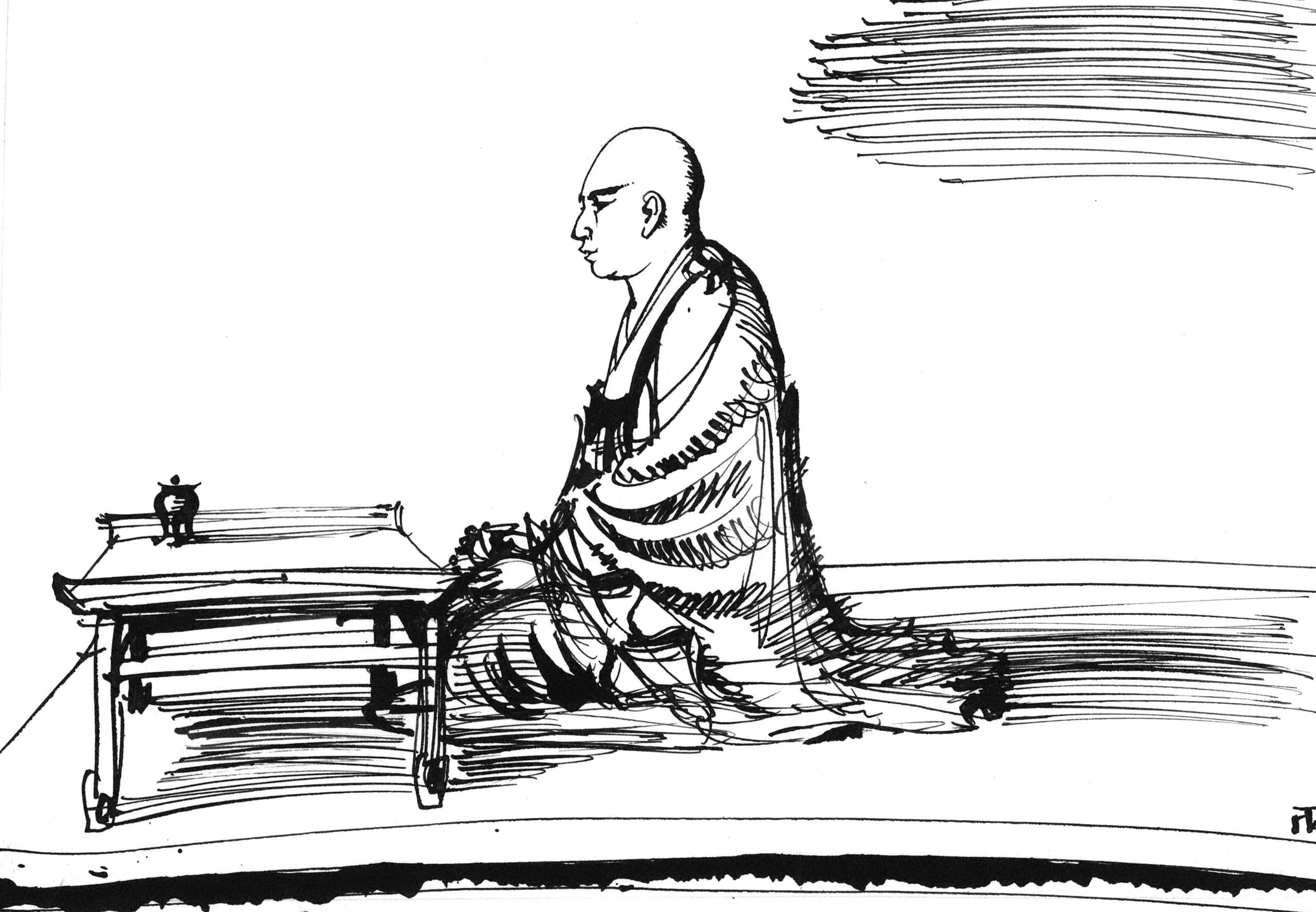Nichiren, who lived during a time of great conflict and upheaval in 13th-century Japan, empathized greatly with the plight of the people and searched for a way to overcome suffering.
His intention was to become a true disciple of Shakyamuni, who taught Buddhism as a way to realize the genuine happiness and dignity of all people. Through his studies of the Buddhist sutras and his predecessors’ commentaries, Nichiren concluded that it is the Lotus Sutra that enables the infinite potential of all people to flourish and permeate throughout society.
In his key treatise titled “On Establishing the Correct Teaching for the Peace of the Land” (Jpn. Rissho Ankoku Ron), he clarified how embracing the teachings of the Lotus Sutra, with their utmost respect for human dignity, would create the foundations of a peaceful society.
Nichiren was strongly determined to actualize such a harmonious society. However, the other Buddhist teachers of the time still adhered to the provisional teachings of the Buddha in an attempt to attract followers and misunderstood Shakyamuni’s true intentions. Additionally, those in positions of secular authority also became followers of and supported these Buddhist teachers.
Although Nichiren suffered oppression and persecution from those in power who adhered to what he saw as mistaken beliefs about Buddhism, he risked his life to encourage and revitalize the people, just as the Lotus Sutra taught. Through this process, he established the practice of chanting Nam-myoho-renge-kyo, inscribing as the object of devotion a scroll or mandala known as the Gohonzon. In this way, Nichiren established a concrete practice for attaining Buddhahood based on the essential teaching of the Lotus Sutra.
Buddhist sutras describe our current age, beginning some two thousand years after Shakyamuni’s passing, as the Latter Day of the Law—a time of tumult and confusion. The Soka Gakkai regards Nichiren as the Buddha of the Latter Day of the Law whose teachings are capable of providing hope in this challenging time and leading all people to enlightenment.
Nichiren’s guiding principle throughout his life was to uphold human dignity as a spiritual backbone for humanity in order to actualize a peaceful world where people can enjoy fulfilling lives.

Nichiren (1222–82), the priest who established the form of Buddhism embraced by members of the Soka Gakkai, is a unique figure in Japanese social and religious history. Within the Soka Gakkai, he is often referred to as “Daishonin,” an honorific meaning “great sage.” A critic of the established Buddhist schools of his time and the secular authorities, he was a person of great warmth and humanity, as is evident in the content of the numerous letters he sent to his followers. It was this deep concern for the welfare of ordinary people that made him such an unrelenting opponent of the often turbulent and oppressive social structures of his time.
In a society that relied on obedience to authority, Nichiren’s life was one of hardship and persecution. It was a life dedicated to propagating a teaching that could liberate people from their sufferings and create the conditions for a society based on respect for the fundamental dignity and equality of all people. This same aspiration inspires the activities of the Soka Gakkai and its members today.
Early Years
Nichiren was born in a small coastal hamlet to a family engaged in fishing—people on the lowest rung of the strict social hierarchy of 13th-century Japan. At the age of 12 (in East Asian age reckoning), he began his schooling at a local temple called Seicho-ji and formally entered the priesthood at the age of 16. Nichiren was moved by the plight of the ordinary people, as seen in the daily hardships of the people of his village. This concern for human suffering was a profound motivational force in his efforts to grasp the heart of Buddhist doctrine. In one of his letters, he describes how, from the time he was a child, he had prayed “to become the wisest person in Japan.”
Following his entry into the priesthood, Nichiren embarked on a period of intense study of the Buddhist sutras and the various schools of Buddhism, spending many years at the major centers of Buddhist learning in Japan.
Establishing His Teaching, Encountering Persecution
At the age of 32, he returned to Seicho-ji where, on April 28, 1253, he announced the conclusion of his studies in a lecture. He declared that the heart of Shakyamuni’s enlightenment is to be found in the Lotus Sutra, which encapsulates the Mystic Law, or truth, to which the Buddha had awakened. Nichiren defined this Law as “Nam-myoho-renge-kyo,” crystallizing in universally accessible form the ultimate reality expounded in the Lotus Sutra. Challenging the major Buddhist schools of his day, Nichiren proclaimed this Law to be the sole teaching capable of leading all people to enlightenment.
Nichiren’s refutation of the established teachings aroused deep animosity from the priests of those schools and their followers, among them influential government officials. From that time on, Nichiren was subjected to constant harassment and persecution.
In 1260, in the wake of a series of devastating natural disasters, Nichiren wrote his most famous treatise, “On Establishing the Correct Teaching for the Peace of the Land.” In it, he developed the idea that only by reviving a spirit of reverence for the dignity and perfectibility of human life through faith in the Lotus Sutra could peace and order be restored and further disaster forestalled. He described his motivation in speaking out as follows: “How could I observe the decline of the Buddhist Law and not be filled with emotions of pity and distress?”
He presented this treatise to the highest political authorities of Japan and urged them to sponsor a public debate with representatives of other schools of Buddhism. The call for public debate—which Nichiren would repeat throughout his life—was ignored, and, the following year, he was banished to the Izu Peninsula.
A Decisive Crisis
During the years that followed, Nichiren’s critique of other Buddhist doctrines invited a series of persecutions from the other schools and from the government authorities. These included armed attacks, ambushes and ultimately an attempt to kill him on the beach at Tatsunokuchi near Kamakura. By his account, moments before he was to be beheaded, a luminous object traversed the sky with such brilliance that the terrified officials called off the attempt. Nichiren was banished to Sado Island where, amidst extreme deprivation, he continued to share his teachings, writing treatises and letters of encouragement to his followers.
Nichiren’s triumph over this persecution at Tatsunokuchi was extremely significant for him. It confirmed that, while he remained an ordinary being, his true and original identity was that of a Buddha devoted to spreading the teaching of Nam-myoho-renge-kyo, providing the means for people to free themselves from suffering at the most fundamental level. It was after this that he began to inscribe the Gohonzon for his followers—a scroll inscribed with Chinese and Sanskrit characters that embodies the Mystic Law to which he was enlightened.
Taking Up Residence at Mount Minobu
In 1274, Nichiren was exonerated and returned to Kamakura, the political center of Japan. He once again urged the government authorities to discontinue their reliance on erroneous teachings, but, for a third time, they declined to heed his advice. He decided then to leave Kamakura and took up residence in the foothills of Mount Minobu, where he devoted himself to fostering disciples who would carry out the work of spreading his teachings after his passing.
In the years that followed, his disciples took the lead in propagation efforts, convincing many people to become followers of Nichiren’s teachings, and solidifying the foundations that would enable his teachings to endure and spread after his passing.
On October 13, 1282, Nichiren’s distinguished life came to a natural close. He had lived true to his convictions and fulfilled his life’s mission: to open the way for the liberation of all people from suffering through the establishment of the teaching of Nam-myoho-renge-kyo and its philosophy of human dignity and empowerment.
The Soka Gakkai regards Nichiren as the Buddha of the Latter Day of the Law (the current tumultuous age predicted in the Buddhist sutras) because his teachings are capable of providing hope in this challenging time and leading all people to enlightenment.
The Soka Gakkai continues to uphold Nichiren’s legacy as a global movement to empower individuals to overcome suffering, live fulfilled lives and contribute to peace in the world.
Source from Soka Global








